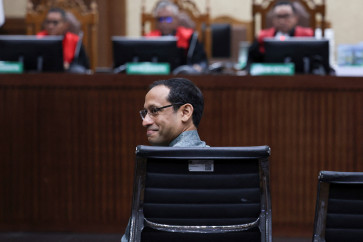Popular Reads
Top Results
Can't find what you're looking for?
View all search resultsPopular Reads
Top Results
Can't find what you're looking for?
View all search resultsA look at the bipolar life
Mainstream films have accustomed us to expect movies to tell romantic tales about the love between a man and a woman, or heroic tales of superheroes and warriors, or horror stories, all following certain set formulas and conventions
Change text size
Gift Premium Articles
to Anyone
M
ainstream films have accustomed us to expect movies to tell romantic tales about the love between a man and a woman, or heroic tales of superheroes and warriors, or horror stories, all following certain set formulas and conventions.
Running alongside these are the products of filmmakers who are seeking to make movies that take a new approach or perspective, and explore alternative cultural values, often using experimental techniques.
One such filmmaker is Paul Agusta. After his first feature film The Anniversary Gift or (Kado Hari Jadi), recently showcased in the Jakarta Film Festival (Jiffest), he is presenting his sophomore effort titled At the Very Bottom of Everything or (Di Dasar Segalanya).
The young director is continuing his exploration of how to bend, twist and rip apart the traditional paradigms of Indonesian filmmaking. He introduces a kind of cinematic storytelling method that is quite new and unconventional in the context of Indonesian cinema in particular.
At the Very Bottom of Everything tells the tale of a young woman's struggle with bipolar disorder, also known as manic depression, a mental illness that causes extreme and uncontrollable shifts in a person's mood.
The bipolar patient's mood can swing wildly from overly "high" or irritable to sad and hopeless, and then back again.
The movie provides viewers with a blunt and moving description of the experience of a bipolar patient through the narration of a young woman (played by Kartika Jahja) who has just recently survived a suicide attempt.
The movie begins with a stop motion animation, portraying a human falling from a high place, followed by the woman's narration.
There are 10 chapters in the film, each of which describes the illness verbally, visually and musically from its onset through its various stages, including the attempted suicide, until treatment is sought, initiated and a balance is reached, Agusta says.
In Chapter 3, titled "Broken Branches", for instance, the woman expresses how she suffers from the illness, which forces her to take medication three times a day to keep her mood in balance, and how it has been haunting generations in her family tree.
Agusta combines his storytelling methods with visual metaphors to describe the main character's various stages of illness.
He uses some of the cast in theatrical-like performances along with stop motion animation using fabric puppets and latex-covered urethane puppets with steel armature.
"I tried to be emotionally accurate in describing the stages in the life of people with bipolar disorder," he says of his choice of the methods.
Consider Chapter 6, for example, which depicts a puppet lying on the floor, trying to move forward slowly and escape from four odd-hooded creatures that suddenly surround it.
Agusta also used rats to portray the pain (of the illness), shooting the scene from every angle as the rats set about eating parts of a bleeding human body, trying hard to escape the rats' attack.
Chapter 8, "the Fight", shows a woman chained to a cross, before she successfully frees herself and sees a bright light.
This scene, Agusta says, "shows how the leading character is finally free from the burden".
The following chapter (nine), "Leveling Out", shows a naked man lying on a floating bamboo raft, before he finally manages to stand up straight on it.
This symbolizes the stage where bipolar disorder patients begin to feel balance in their lives.
The last chapter is a portrayal of the stage where the patient no longer feels afraid. The main character says that she finally knows what she has to do to be OK, avoiding stress and filling her days with positive things.
At the Very Bottom of Everything offers a look at the dark side of bipolar disorder patients with their depression problems. Paul admits that the film is based on his personal experiences.
The aim of the film, he says, is to educate people about the illness.
"The public tends to dismiss them *bipolar disorder patients* as *crazy' without having any understanding of the fact that this can be treated and managed so that they can live normally," he says.
"I want to show that it *bipolar disorder* can happen to anybody, at whatever age and gender."
At the Very Bottom of Everything is produced by Kinekuma Pictures (formerly HouseofWaves Productions) in cooperation with PT Visi Integra Media (vi.em) and funded in part with a grant from the Digital Production Fund from the Hubert Bals Fund of the International Film Festival Rotterdam in the Netherlands.
The world premiere of the film will be at the 2010 International Film Festival Rotterdam, which runs from Jan. 27 to Feb. 7.
Screenings of the film will also take place in Indonesia in March.
At the Bottom of Everything (Kinekuma Pictures, 84 minutes)
Indonesian with English subtitles
Directed by Paul Agusta
Starring Kartika Jahja, Teuku Rifnu Wikana, Bianca Timmerman, Primawan Luqman Hakim, Tejo Aribowo










